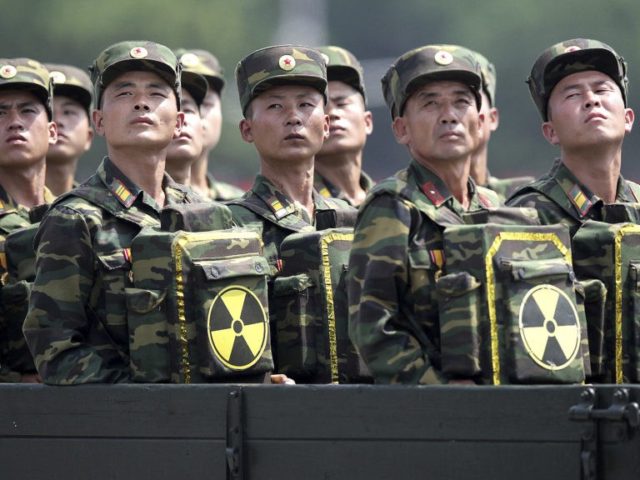Millions in South Korea could die if war breaks out on the Korean Peninsula, including hundreds of thousands of U.S. troops and Americans civilians who live there, according to a recent study.
Estimates range between 30,000 and 300,000 dead in the first days of fighting, or even the first few hours. If the war escalated to a nuclear level, the toll could be tens of millions of casualties, according to the Congressional Research Service.
“A conflict itself, should it occur, would likely be significantly more complex and dangerous than any of the interventions the United States has undertaken since the end of the Cold War, including those in Iraq, Libya, and the Balkans,” said the report, published in November.
Defense Secretary Jim Mattis, the report noted, has said that although the U.S. would likely prevail in the war, “it would be the worst kind of fighting in most people’s lifetimes.”
The report comes as the Trump administration is grappling with how to stop North Korea from its goal of obtaining a nuclear weapon that could hit anywhere in the continental United States.
Pyongyang has sped up its efforts within the last year, successfully testing an intercontinental ballistic missile that could hit the United States in July, but not yet demonstrating whether it can marry the missile with a miniaturized nuclear warhead that can survive reentering the earth’s atmosphere.
Some estimates say Pyongyang could achieve that goal sometime in 2018.
The administration is pursuing a diplomatically-led strategy that aims to exert “maximum pressure” to convince North Korea to denuclearize, primarily through unilateral and multilateral sanctions, and exerting diplomatic and financial pressure on China to do more to influence their client state.
Administration officials have also made clear there are military options, and talk of those options has grown louder as the clock ticks down, including discussion of preventive attacks that risk escalating into a full-blown nuclear war.
One preventive measure outlined in the report would be to shoot down North Korea’s medium- and long-range missile tests, which allow them to gain valuable information towards achieving its goal.
However, that could risk failure to shoot down a missile and undermine the U.S.’s deterrent capability. It could also risk a military response from North Korea that could spiral into conflict.
Another preventive measure would be to take out North Korea’s ICBM facilities and launch pads through airstrikes, cruise missile attacks, and special operations direct action missions on the ground. However, that option also risks not taking out all such facilities and motivating North Korea to move more aggressively.
The U.S. military could also seek to take out North Korean nuclear facilities: reactor complexes, uranium mines and enrichment facilities, plutonium extraction facilities, research and development facilities and explosive test facilities, using air strikes, cruise missiles, and ground attacks. However, skeptics argue this would only set North Korea back several years at best, could result in widespread contamination, and prompt North Korea to launch a conventional military attack against South Korean and U.S. military and civilian targets.
Another potential option is to seek North Korean regime change, which the Trump administration has said it has no interest in. This would involve strikes against nuclear infrastructure, command and control facilities, key leaders, artillery and missile units, chemical and biological weapons facilities, airports, ports, and other infrastructure deemed critical to regime survival.
However, this option involves a “high degree of military and political risk,” and would be difficult to launch in secrecy, risking a preemptive attack against military and civilian targets by North Korea.
“Such a large-scale attack, opponents of pursuing regime change may say, could result in an escalation to a full-scale war if North Korea believes the operation is intended to decapitate the regime,” the report said.
In addition to millions of deaths, the report also warns that any military conflict risks destruction of South Korean’s economy — the 11th largest in the world, and would take significant reconstruction efforts, and limit the U.S.’s ability to respond to other crises in the world.
Any conflict could have an impact on the U.S. relationship with China, allies South Korea and Japan, Russia, and other countries in the region. If China or Russia decides to enter the war, the outcome would be even less predictable, the report notes.
Non-preventive military options include maintaining the status quo; increasing deterrence against any use of nuclear weapons by building up military assets in the region; and withdrawing all U.S. forces from the Korean Peninsula, whose presence and military exercises in the region angers Pyongyang.
However, those options risked not being able to stop North Korea from obtaining a nuclear weapon that could hit Washington, which could kill millions of Americans, harm U.S. alliances in the region and the U.S.’s global leadership role, spark a nuclear arms race in East Asia, and increase proliferation of nuclear technology and material to other bad actors.
Given those enormous implications, the Trump administration is reportedly considering preventive measures, stoking fears of a war. Some experts believe the administration is bluffing in order to get China and North Korea to cooperate. They also argue that talk of a preventive attack could end up provoking North Korea into attacking first.
Although tensions on the Korean Peninsula have cooled in recent weeks, the next flashpoint could come in February, when South Korea is slated to host the Winter Olympics. Experts fear it could present the perfect opportunity for North Korea to conduct a major test of some sort.
Mattis suggested on Friday that the U.S. could reschedule joint military exercises with South Korea during that time, but said there are no plans to pause them.

COMMENTS
Please let us know if you're having issues with commenting.